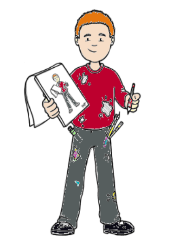Artists at Queen's Crescent School
Being an Artist
Lead Artist: Mrs Bryony Peters
Intent:
Art, craft and design embody some of the highest forms of human creativity. A high-quality art and design education should engage, inspire and challenge pupils, equipping them with the knowledge and skills to experiment, invent and create their own works of art, craft and design. As pupils progress, they should be able to think critically and develop a more rigorous understanding of art and design. They should also know how art and design both reflect and shape our history, and contribute to the culture, creativity and wealth of our nation.
Aims:
The national curriculum for Art aims to ensure that all pupils:
- Produce creative work, exploring their ideas and recording their experiences
- Become proficient in drawing, painting, sculpture and other art, craft and design techniques
- Evaluate and analyse creative works using the language of art, craft and design
- Know about great artists, craft makers and designers, and understand the historical and cultural development of their art forms.
How do we teach Art and why has this approach been chosen?
Children frequently work as artists through their enquiry question- this could be as part of asking ‘What is Creativity?’ or ‘What do artists do?’. Our children develop a wide range of artistic skills and techniques which progress through the year groups, using the national curriculum guidance as a starting point but adding our own knowledge and skills, for example making sure that children are exposed to a diversity of artistic styles and artists from history and from modern times as well as from a range of cultures and with a focus on the use of sustainable materials.
Children from Year 1 upwards, revisit and progress their skills in each aspect of art, as part of their enquiry questions as they move through the school. Our Art curriculum progression document is used in order to ensure knowledge and skills build year on year. This ensures that by the end of year 6, pupils have the skills and knowledge to support their future studies.
What our Art lessons involve:
| Re-cap prior knowledge |
These information recall activities may involve :
|
| New information presented in small and simple steps |
Children are then given time to practise applying new knowledge or skills, often in sketchbooks. |
| Teachers pose carefully considered questions |
This allows pupils to deepen their understanding |
| Clear modelling |
Teacher demonstrates a new concept or skill to build on previous learning and further develop techniques. |
| Scaffolding |
Children’s activities are matched to their needs. The learning is broken up into chunks and pupils are provided with the tools and structures needed to be successful. |
| Working Walls |
These are used to display the learning journey through an enquiry. |
Children’s learning is documented through sketch books and enquiry books
Art outcomes:
Art is monitored by the Art lead throughout the year in the form of sketch book looks, lesson observations and pupil conferencing. Classroom displays evidence the work the children have completed throughout an enquiry block.
Teachers continually assess children in Art lessons and complete an enquiry assessment at the end of each enquiry. Progression grids act as a reference for end of year expectations for each year group and teachers are aware of the entry and exit points for their children.
The lead Artist works closely with the link governor to assess the impact of the Art curriculum each year.
|
|
|
 |
|
|
|
 |
|
|
|
 |















